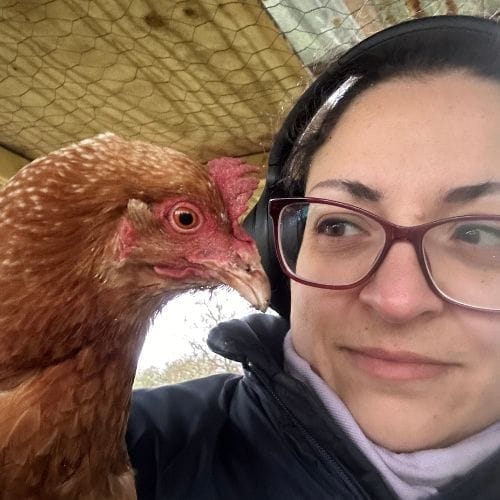
This site uses affiliate links and I may earn a small commission when you use my links and make a purchase without incurring additional fee yourself. Many thanks for supporting this website.
Please click here for more details.
Winter Chicken Care: How to Boost Egg Production
When the mornings are frosty and the daylight slips away too quickly, many chicken keepers find themselves staring at an empty egg basket. Your hens, meanwhile, are perched smugly in the coop, muttering something that sounds suspiciously like “Eggs? In this economy?”
Don’t panic. It’s perfectly normal for egg production to slow down in winter, but there are practical steps you can take to keep your girls happy, healthy, and laying. Grab your coffee (and maybe a woolly hat) while we go through the best winter chicken care tips to boost egg production—without turning your coop into an electricity-guzzling sauna.
Winter Chicken Care: How to Boost Egg Production
Why Do Chickens Lay Fewer Eggs in Winter?
Hens aren’t lazy—they’re just tuned in to nature. Egg laying is closely linked to daylight hours. When the sun sets at 4 pm, your flock’s internal clock says, “Time for a rest!”
Shorter days = fewer daylight hours to trigger the reproductive cycle.
Temperature stress: chickens spend more energy keeping warm instead of making eggs.
Molting: late autumn is prime feather-shedding season, and regrowing a whole wardrobe takes energy.
Energy balance: if they’re burning calories for warmth, egg production slows.
Understanding these natural rhythms is the first step toward gently encouraging your hens to keep producing.
1. Optimize Daylight: The Role of Supplemental Lighting
Hens need about 14–16 hours of light daily to stay in peak laying condition. In the UK (and most northern climates), winter daylight falls short of that.
The fix? Supplemental lighting in the coop.
Use low-watt LED bulbs on a timer to mimic sunrise.
Add light in the morning, not late at night—this keeps their bedtime natural.
Never leave lights on 24/7; hens need darkness to rest. Also, increased hours of light increases aggression.
Zia’s Tip: Think of it like a gentle alarm clock for your hens. You wouldn’t want someone flicking the bedroom light on at midnight either, sì?
2. Keep the Coop Warm (But Not Too Warm)
Here’s the trick: hens are surprisingly cold-hardy. What bothers them most isn’t the chill—it’s drafts and dampness.
Deep litter method: let bedding build up over the season. It insulates the coop and generates mild heat.
Seal drafts but keep ventilation—moisture causes frostbite faster than cold air.
Safe heating options: flat-panel radiant heaters or brooder plates are better than risky heat lamps.
Zia’s Reminder: A cozy, dry coop is like a snug Italian trattoria on a snowy night—warm enough to relax, but not so hot the wine goes bad.
3. Nutrition Upgrades for Winter Egg Production
Eggs don’t appear out of thin air—they’re built from protein, calcium, and vitamins. In winter, hens need a little extra boost.
Higher-protein feeds (16–18%) help with post-molt recovery.
Calcium supplements: oyster shell, crushed eggshells.
Warm mash: a little cooked oats or scrambled egg as a treat.
Supplements: poultry vitamins or probiotics to support immunity.
Zia’s Tip: Toss a few warm kitchen scraps in the evening (pumpkin, cabbage, or leftover rice). It’s the chicken equivalent of a midnight pasta snack.
4. Fresh Water in Freezing Weather
Hydration is non-negotiable. A hen without water is a hen without eggs.
Check waterers twice daily in freezing conditions.
Use heated chicken waterers or a simple plug-in heater base.
Place waterers in sheltered spots to prevent ice buildup.
5. Reduce Stress for Happier, Productive Hens
Nobody lays well under stress—humans or chickens. Keep winter boredom and stress at bay:
Hang cabbages, scatter grain, or provide dust baths in sheltered corners.
Ensure secure runs to prevent predator pressure.
Keep flock size appropriate—overcrowding causes bullying.
Zia’s Note: Think of your coop as a tiny Italian piazza. A bit of entertainment, good food, and safety from bandits = happy hens.
6. Track Egg Production & Flock Health
Monitoring helps you spot patterns—and potential problems.
Note how many eggs you’re collecting daily.
Record feed changes, lighting adjustments, or health issues.
Compare winter vs. summer production to see what’s working.
Conclusion: Your Winter Egg Basket Doesn’t Have to Be Empty
Egg production in winter doesn’t have to grind to a halt. By adding a touch of light, keeping the coop warm and dry, upgrading nutrition, and reducing stress, you can enjoy steady egg collection all season long.
Remember: happy hens = full breakfast plates.

Zia Paola
Zia Paola is a burnout survivor, chicken enthusiast, and former veterinary surgeon turned digital mischief-maker. She writes from her semi-chaotic smallholding in the UK, where she splits her time between unhinged chickens, rustic recipes, and helping others reclaim their lives from hustle culture. You can find her ranting lovingly about slow living, food, and freelance freedom at www.badinfluenzia.com.

Get mildly chaotic life advice, anti-burnout rants, and unsolicited chicken wisdom delivered straight to your inbox. No fluff. Just feathers.
Created with ©systeme.io



